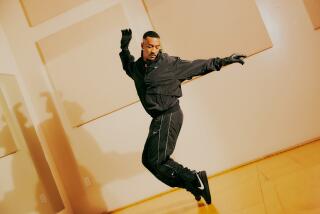Retracing Steps of Tap’s History
- Share via
Laurie Winer’s review of the New York tap dancing musical “Bring in ‘Da Noise, Bring in ‘Da Funk” (Calendar, Nov. 25) states that “the show’s thesis is that tap was born when American slaves were forbidden their tribal drums.” That simplistic thesis ignores the actual tap dance antecedents of Irish and Scottish solo step dancing and English clog dancing, which, blended with African dance movements, gave rise to indigenous American tap dancing.
Irish step dancing in the 1700s, as today, used intricate leg movement and fast footwork in jigs and reels. Tapping was done with toes and heels of hard shoes; arms and upper body were kept motionless to concentrate attention on the feet.
In clog dancing, wooden-soled shoes (clogs) were worn to accentuate the rhythm of the feet; this was common throughout Europe, Ireland and northern England. There, the Lancashire Clog was a favored folk dance by the mid-1700s; like Irish step dances, upper-body movement was minimized.
By the early 1800s, as dance tempos increased, wooden soles were replaced by flexible leather, with English copper pennies nailed to the heels to emphasize sound.
African tribal dances of the time utilized the whole body, not just the feet. Dance steps were done almost completely flat-footed, with little delineation of heel and toe movement; shoeless feet on bare earth made little sound.
Dancers concentrated on vivid body movements involving head, shoulders, arms and hips along with constant improvisation, using gliding, dragging and shuffling steps. Skill was measured by the dancer’s agility in bending, crouching and flexing the entire body, not in the performance of certain steps.
The 1739 slave insurrection in Stono, Va.--triggered when African slaves drum-beat a message of revolt to alert slaves at neighboring plantations--led to passage of the 1740 Slave Act, forbidding slaves from “beating drums, blowing horns or the like.” To substitute for musical instruments, hand claps and foot beats were used, creating a music form where dancers made their own rhythms and sounds.
*
These new rhythms were subsequently applied derisively to European dances on plantations, frequently for the amusement of white owners. For example, the Cakewalk, where a cake prize was given to the slave who performed the fanciest walk before a white audience, was a parody of the minuet grand march at whites’ fancy parties. Slaves also copied techniques of Irish jig dancers visiting the plantations.
In Louisville, Ky., in 1828, a white dancer calling himself “Jumping Jim Crow” did a parody-in-blackface of this new slave dancing. The minstrel show was born; whites parodied blacks parodying whites. In 1844, a free-born black dancer, “Juba, King of All Dancers,” fused European steps with African rhythms before white audiences in public competitions with an Irish jig dancer; he was the major black minstrel-era dancer in America and Europe.
Buck dancing was the earliest combination of basic shuffle and tap steps, performed to syncopated rhythms, in which the accent is placed on the down or off beat--a style derived from African tribal music. There were two distinct dance techniques by late 19th century, buck-and-wing and soft-shoe. The former was active, fast and danced in wooden or hard leather-soled shoes. Soft-shoe was relaxed and smooth. It developed from dances like the German-Irish waltz clog, fusing German immigrant folk dancing with Irish jigs, and from slow-tempoed shuffles like the “Essence of Old Virginia.”
Synchronized tap dancing was introduced by the Floradora Girls in 1900, and the term “tap and step dancing” was introduced in a 1902 minstrel show. Metal cleats were now worn on heels and toes of leather shoes. As vaudeville supplanted minstrel shows, tap dancing developed with great vigor in two different paths, one white and one black. One led from George M. Cohan to Fred Astaire. The other produced the great Bill Robinson--”Bojangles”--a contraction for bone jangler or a musician who beats time by clapping together a pair of bones. He was the first black dancer to headline his own show on Broadway in 1930; he made 14 films.
Tap dance did not develop in linear progression from a single ethnic source; it is a uniquely American creation resulting from a blending of cultures, of Old World traditions and New World imagination, and drew equally from Europeans and Africans to make a new dance form.
More to Read
The biggest entertainment stories
Get our big stories about Hollywood, film, television, music, arts, culture and more right in your inbox as soon as they publish.
You may occasionally receive promotional content from the Los Angeles Times.










